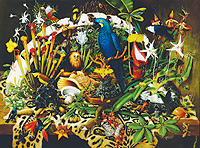Isabella Kirkland's artistic journey has been a circuitous one that has eventually led her home. From sculpture to conceptual installations to taxidermy, this Sausalito, Calif.-based artist has tried her hand at a number of mediums. But it wasn't until the dawn of the 21st century that she began her unique "TAXA" series, an exquisite body of oil paintings headlining the Sun Valley Center for the Arts' current show, "Biodiversity: Order, Consumption & Man."
In "TAXA" (the Greek word meaning order, as in taxonomy), Kirkland has achieved two bold accomplishments. First, she has visually catalogued nearly 400 plant and animal species, each a life-sized depiction, researched with scientific rigor. Second, Kirkland has reinvigorated a centuries-old style of painting whose popularity reigned for hundreds of years. Academic realism, and naturalistic realism in particular, was a favored theme among northern European artists from the Renaissance through the end of the 19th century.
After Kirkland graduated with a degree in sculpture from the San Francisco Art Institute in 1978, she began her career in conceptual art installations—a genre fitting for the time and drastically different from the grand oil paintings of "TAXA."
She describes her early sculptural installations as transitory; the modernist creations toyed with classic definitions of art. Hers was part of an artistic lineage beginning with Marcel Duchamp's "Fountain," the urinal widely considered to be the first conceptual art work.
"I was using unusual materials. I was using refuse," she said. Enshrined garbage is certainly a far cry from the studied academic creations she labors on today, but for the past 30 years or so, such conceptual installations have been more widely embraced by the contemporary art establishment than naturalist still-life paintings.
Some conceptual pieces she created were overtly symbolic and witty. In 1986, an installation in New York City called "Night of Fog" featured blocks of dry ice carved into the words "love," "fame" and "fortune."
"Of course, they evaporated," Kirkland said, reminded of the joke.
During 20 years practicing installation art—exhibits whose temporary nature were the whole point—Kirkland began to drift towards deeper questions of permanence and durability.
Soon, she was dwelling on art's lasting power, pondering "what kind of messages would be interesting to send out over a long period of time."
While living in New York, Kirkland practiced a different sort of art, yet one also concerned with durability and permanence: taxidermy.
She was, as far as she knows, the only practicing female taxidermist in Manhattan.
"I'm waiting to be challenged on that," she said, with a laugh, of the unique skill she acquired while working at the California Academy of the Sciences. Taxidermy, the art of preparing lifelike models of animals from dead specimens, provided Kirkland with a variety of pleasures.
"I adored it. It's incredible sculpture practice and there is an amazing transformation that takes place from a dead thing to a preserved sculpture using parts of the dead thing."
Through this resurrective art, she learned trade skills unheard of for a woman at that time. "I can skin just about anything," Kirkland said.
Breaking gender barriers has also been an important theme for Kirkland and this iconoclastic nature eventually led her back to oil painting.
"Of course everyone says you can't do it; you can't do something new in painting."
But, by the late-1990s, she had made significant two-dimensional inroads and began working on naturalist themes in a series called "Nature in the Margins." The series included images of rare animals in human environments—a jaguar on a golf course—and raised questions of how wildlife survived through the scourge of man's development.
Though she didn't know it at the time, "Nature in the Margins" were Kirkland's studies for "TAXA." The animals were detailed and the overarching philosophy questioned relations between biodiversity and man.
In 1999, "TAXA" was officially born of an innocent-seeming piece of mail. The Sierra Club sent out a list of the 100 most endangered species in the United States. Kirkland's light bulb was lit.
She had an "a-ha" moment as two parallel tracks in her mind—the durability of art and naturalist painting—finally merged into one coherent message. She has been working on "TAXA" ever since.
The exhibition at The Center represents the first time the complete collection of "TAXA" paintings will be shown together.
"TAXA" consists of six paintings—"Descendant" (1999), "Ascendant" (2000), "Trade" (2001), "Collection" (2002), "Back" (2003) and "Gone" (2004)—each a visually and academically exhaustive categorization of flora and fauna.
"Gone," the most recent and macabre, depicts 63 extinct species. "Trade" is a colorful tableau of exotica that is harvested, poached and eventually sold through both legal and illegal markets around the world.
Months of research are required to paint just one animal species. Kirkland scours hundreds of photographs and consults everything from zoologists to live animals in zoos.
The paintings' reminiscence to Dutch master works is not coincidental. The studious oil paintings of 17th century northern Europe are some of the most durable works of information ever created, outlasting other forms of technological documentation such as computer languages, Kirkland points out.
"TAXA" enshrines animals that we are losing right now, in a medium that should last centuries.
The point, Kirkland said, is "to take these things we might lose and preserve them as lifelike as possible so that people in 400 years can look back and see how amazing what was lost."
Kirkland in Ketchum
TAXA is on display at the Sun Valley Center for the Arts in Ketchum. Isabella Kirkland will deliver an informal lecture on Thursday, Feb. 16, at 7 p.m. On Friday, Feb. 17, the artist will be in attendance for Gallery Walk through 8 p.m. and will give a short talk at 6:15 p.m.


 TRADE (2001), an oil and alkyd painting on canvas by Isabella Kirkland, depicts 68 species threatened by poaching and trade in international markets, legal and otherwise.
TRADE (2001), an oil and alkyd painting on canvas by Isabella Kirkland, depicts 68 species threatened by poaching and trade in international markets, legal and otherwise.



































